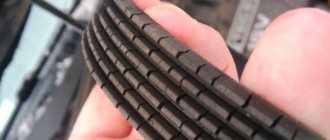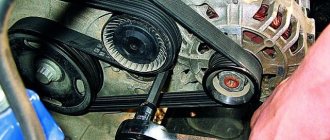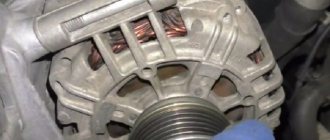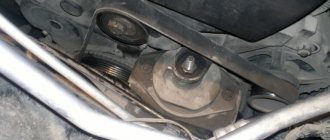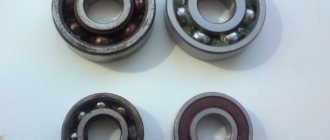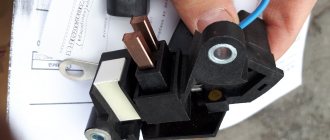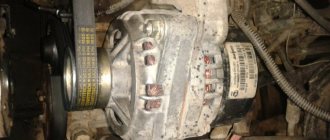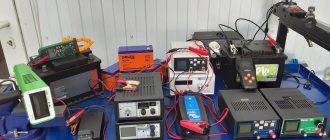The performance of the internal combustion engine depends on the quality of the generator. After the engine starts, the device is the main source of electricity on board the car. However, in order for the rotor to rotate smoothly, it is necessary to properly tension the car’s alternator belt, otherwise problems with current generation will occur.
How to tension a car's alternator belt.
The importance of belt tension
The degree of belt tension in a given belt drive is a critical parameter that it is advisable for car owners to regularly monitor. With significant weakening, there is a risk of slipping along the pulley profile, because rotation is transmitted due to friction. Due to the low interference, the friction coefficient decreases, and the voltage generation is lower than the standard established by the car manufacturer. Due to low voltage, negative factors arise:
- lack of battery charging;
- the on-board electrical system experiences a voltage shortage;
- electrical appliances included in the circuit operate with increased load, which negatively affects their service life.
Important! Weak tension on the alternator belt causes it to slip, heat up due to friction, and lead to rapid failure due to loss of its performance characteristics.
Motorists should also not tighten the strap too much. Such actions will also not bring positive results. Great effort results in rapid wear and also often leads to the transmission breaking at an unexpected moment. A high tension force negatively affects the operation of the bearings, which must be installed on the generator output shaft and on the crankshaft output shaft. Exceeding the optimal load accelerates their production. Long-term operation in extreme conditions reduces their service life.
Timing belt tensioner VAZ 2112 (16 cells)
Using a special wrench, tension the timing belt using a tension roller.
If it is not there, then you can tighten the timing belt using two nails and a screwdriver, which will be installed between them. You can also convert a table fork into a suitable tool by breaking off 2 central teeth, and shortening and bending the outer ones. Having turned the crankshaft two turns in the direction of rotation, we check the alignment of the installation marks. We check the tension of the toothed belt in the middle part of the branch between the camshaft pulleys. The belt deflection should be 5.4±0.2mm. under a load of 100 N (10 kgf). And how to check the timing belt tension without a special tool? How do you know how hard to press on the timing belt? Method No. 1
. Use 10kg. weights and ruler. Place a ruler on the belt between the pulleys and a weight on the ruler. We pull so that the deflection from the plane is no more than 5mm.
Method No. 2
.
Use steel scales. Attach the hook of the scale to the center of the belt between the pulleys and pull them up until the reading on the scale is 10 kg. After this, we measure the distance by which the timing belt has deviated (should be 5.4 ± 0.2 mm). By the way, the same tool is used to tension the generator belt and nuts: By analogy with 8kl.
motors: if you don’t tighten it enough, the belt will dangle and hit the plastic casing. In conclusion, if you have over-tightened the timing belt, then it will squeal and the service life of it, as well as the coolant pump bearings and tension pulley, will decrease. It's better to under-tighten than over-tighten. And yet, measurements must be performed on a cold engine.
By the way, do you know
The alternator belt on the VAZ 2114 is installed in order to transmit rotational motion from the engine crankshaft to the generator drive, which, when the engine is running, charges the battery and powers the electrical consumers included in the vehicle's electrical circuit.
Since the engine installation on the VAZ 2114 is transverse, the VAZ 2114 alternator belt is accordingly located on the right side of the car or on the left side of the engine, if you look at it with the hood open from the cooling radiator side.
At the end of the crankshaft opposite the flywheel there is a timing belt drive pulley, which spins the camshaft and oil pump shafts with a pump, as well as the electric generator drive pulley. The timing drive is covered by a plastic cover, and the belt drive runs outside, on top of this cover, and connects the electric generator drive pulley on the crankshaft to the alternator pulley. On the VAZ 2114 there is no belt tensioner pulley, like on the VAZ 2110. Tensioning the generator belt is done in a different way.
The belt drive is marked 21082-3701720 and when choosing, you need to look for a belt with a length of 698 mm. During operation of the machine, this drive is exposed to serious loads, not only mechanical, but also thermal and chemical. Therefore, high demands must be placed on the quality of the belt drive. Many experts and car enthusiasts recommend using BOSCH or GATES brand belts. And although they cost about 500 - 550 rubles, versus 200 - 300 rubles for products from a Russian manufacturer, the quality of these drives is much higher.
How to check tension
Before checking the tension of the generator belt, it is necessary to take into account that the optimal value depends on many external factors, which include:
- car make and model;
- type of generator installed under the hood;
- type of belt used to transmit rotation.
What level of belt tension on the alternator should be in a car can be found in the instructions for the car brand. Also, manufacturers of generators and belts regulate the value, indicating it in the data sheet attached to the products. The parameter is influenced by the presence of additional connected equipment. Such components include generators, hydraulic and electric power steering. Not in all conditions it is possible to obtain accurate information about the electrical equipment installed in the car. In such situations, experienced drivers are guided by a universal rule, which applies to a large number of domestic and foreign cars.
Important! For many vehicles, tension testing is performed on the longest straight section of the belt between the pulleys. After applying a force equivalent to 10 kg, the belt deflection should be approximately 10 mm.
For example, in VAZ 2115 models, generators of different models can be installed depending on the year of manufacture of the car. There are brands 37.3701 or close analogues 9402.3701. In the first case, a deviation of 10-15 mm at 10 kg is acceptable, and in the second case, the interval is limited by manufacturers to 6-10 mm.
Signs of weak generator drive tension
The motorist will be able to determine the insufficient level of tension by indirect signs that quickly appear in any brand of car. Most often you should be wary in the following cases:
- whistling sounds are heard from under the hood during engine operation, so it’s worth looking into this area and confirm/refute doubts;
- some (or all) electrical appliances function intermittently or abnormally;
- The battery charge level light on the instrument panel continuously lights up during travel.
The indicator on the dashboard can be in the form of a battery icon or a corresponding abbreviation. It is worth paying attention to her behavior.
When is it necessary to replace the alternator belt on a car?
If you use high-quality components that are recommended by the manufacturer, then changing the alternator belt costs once every 60 thousand kilometers. It is better to occasionally look at the belt and replace it if there are microcracks. Also, replacing this unit may be necessary if specific sounds are heard from under the hood, such as a whistle or a belt slipping on the pulleys. But in this case, you can not immediately change it, but simply tighten the belt more.
Unpleasant sounds often occur due to the fact that the belt is poorly tensioned. It may have stretched a little or the fastening may have become loose, causing the possibility of slippage. If the belt has been serving for a long time and has begun to show certain problems, it is better to replace this part. The replacement process is carried out with the following steps:
- selection of the required material in a car store, taking into account the manufacturer’s recommendations;
- removing the old belt, careful handling of all generator fasteners;
- checking the functionality of the pulleys and shafts of the mechanism;
- installation of a new belt and its correct tension in compliance with the requirements;
- checking the functionality of the equipment.
If the belt tension is not strong enough, the drive shaft pulley will spin on the belt and the generator will not generate electricity efficiently. Also, with such problems, the alternator belt quickly heats up and loses its normal properties. You will soon have to change the belt again if you do not ensure proper tension.
If you overdid it during installation, then get ready to replace or overhaul the generator. If the tension is too strong, the generator bearings fail, which often leads to the need for a complete replacement of this unit. So it is important to maintain correct and complete belt tension, which will ensure long and correct operation of this entire mechanism.
Drive belt tension options
Depending on the design features of the car, manufacturers install various tensioner options under the hood. Such units are in demand if drivers detect sagging belts or excessive overtightening, which may have been allowed at the station after maintenance. Most often, you can adjust the load on the belt connecting the generator and the crankshaft using regulators, in which the force is transmitted through one of the types of element:
- bar;
- bolt;
- video clip.
All designs have their positive and negative characteristics.
Tension with adjuster bar
The technique is more relevant for older generation cars, for example, “classics” from VAZ. The method is to fix the generator on the housing using an arc-shaped strip clamped with a bolted connection through a groove. By loosening the thread, you can move the generator to adjust the force. The following algorithm is used:
- unscrew the fastening nut one turn or half a turn to loosen the bar that acts as a belt tensioner;
- we use a pry bar to pry up the body of the electrical appliance, which must be tensioned by the generator belt to an acceptable level to ensure the required tension;
- tighten the fasteners, fixing the generator in the new position.
Since the process is relatively labor-intensive, it can be repeated as needed.
Tension using adjusting bolt
A more progressive method is to adjust and fix the tension of the generator belt using an adjusting bolt. By moving it along the thread, you will be able to achieve the desired result. The step-by-step algorithm includes the following positions:
- First of all, we loosen the mount of the generator;
- then use a wrench to unscrew/tighten the adjusting bolt;
- tighten the upper and lower bolts securing the generator.
The advantage of this method is that the car owner has the opportunity to control the degree of force directly during the adjustment process. It is important to take into account the error that occurs when tightening fasteners.
Optimal tension adjustment via roller
On certain models of modern cars, a structure with a roller is installed to comfortably loosen the belt. For example, this is how the generator at Priora is weakened. It should be taken into account that the installed belt is also used to ensure rotation of the air conditioner and power steering. A special roller is an integral part of the design. To work with Priora, an auto mechanic will need a 17-size open-end wrench. It will help loosen and tighten the threaded system. In addition, you will need a special key used to rotate the roller. The special device looks like a key with a handle, the working end of which has two rods with a diameter of 4 mm, a length of 25 mm, located at a distance of 18 mm perpendicular to the handle.
Important! It is not recommended to use tools not intended for this operation for adjustment, for example, bent pliers or other homemade products, since with their help you can not only loosen the belt, but also damage the tensioner on the generator.
The cost of a special key usually does not exceed 80-100 rubles. They search for it using the encoding 67.7812-9573. Having selected the optimal force, use a 17 wrench to tighten the adjusting rollers. Access to the settings is simple; it opens from the top from under the hood. You can check the degree of tension after starting the engine and turning on electrical appliances. They should work as normal. While the engine crankshaft is rotating, the “Battery” dashboard light should not light up, and the belt whistle should not appear. Manufacturers recommend monitoring the force on the belt at least every 15 thousand km. Mandatory replacement of consumables is carried out no later than 60 thousand km. Since the product can stretch over time, we recommend periodically checking its performance several times a season.
It is important after all the adjustment work, after driving a couple of kilometers, to check that the strap is not too tight or sagging again. Such control will give complete confidence in the correctness of the operations performed.
How to tighten the alternator belt
The question of how to tension the generator belt can be easily resolved using an adjusting bar and an adjusting bolt. Using a strap, tensioning the alternator belt is not difficult.
- The nut located on the bar is unscrewed;
- The position of the generator is adjusted using a handy object (a pry bar will do);
- The new position of the generator should be secured with a nut.
The belt drive is adjusted using the adjusting bolt according to the following scheme:
- The generator mounts are loosened at the top and bottom;
- The adjusting bolt turns;
- The generator is removed from the block, and the tension is checked at the same time;
- Tighten the generator mount.
More modern and simpler is adjustment with a tension bolt.
What happens if you drag
Not all motorists know what will happen if drivers overtighten the belt during tensioning. Increased load increases wear on the unit. It manifests itself in the form of a characteristic hum from an electrical appliance. The main noise comes from bearings and rollers, which will create increased tension. Due to pinching, it will be more expensive to repair the water pump or air conditioning compressor involved in the circuit. It is worth paying attention to the special marks used by manufacturers to monitor tensioner wear and timely replacement of the belt.
